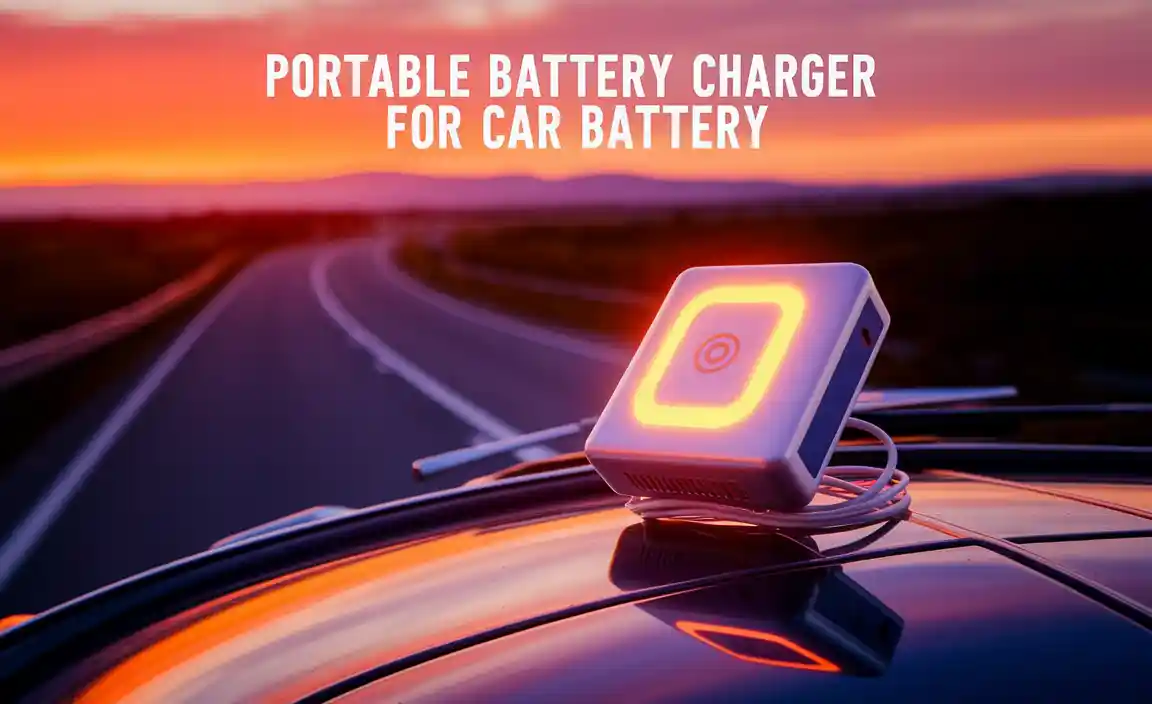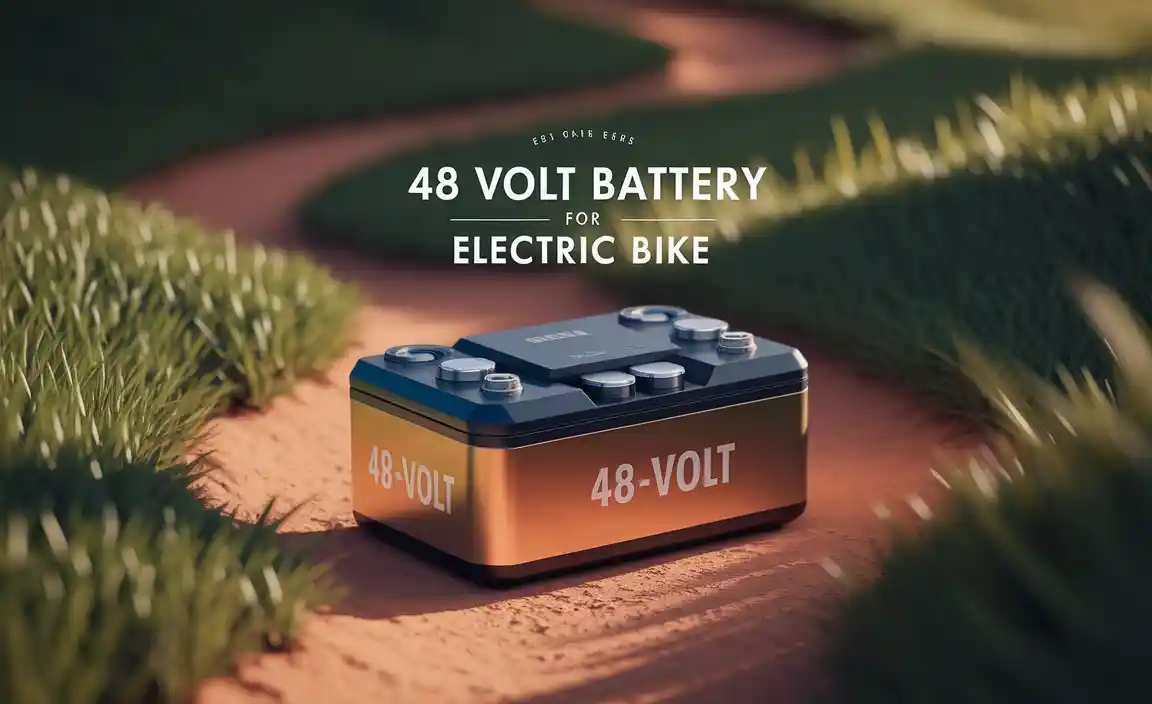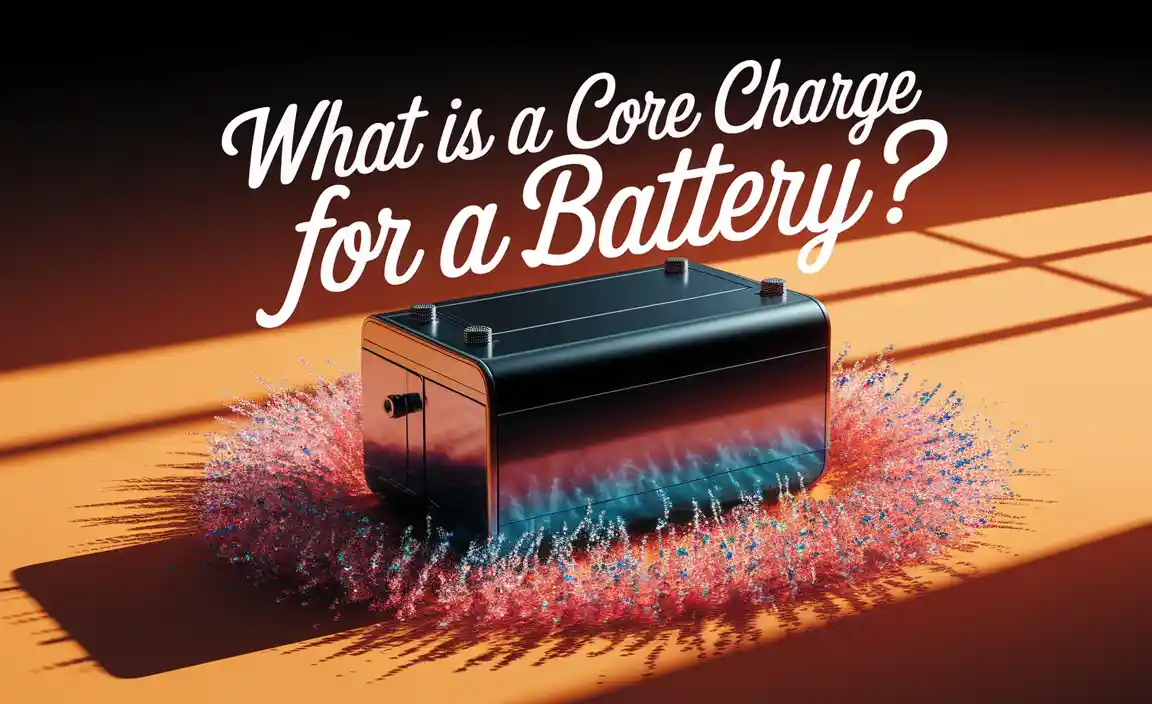An AGM battery for a car is a type of lead-acid battery that uses absorbed glass mat (AGM) separators to hold the electrolyte. They are known for being maintenance-free, spill-proof, and offering better performance and longevity than traditional car batteries, especially in modern vehicles with high electrical demands.
Thinking about your car’s battery can feel a bit overwhelming. You hear terms like “traditional” and “AGM,” and it’s hard to know what’s best for your ride. Don’t worry, I’m here to break it down in a way that makes sense. Your car’s battery is the heart of its electrical system, and understanding it means you can take better care of your car.
We’ll cover what an AGM battery is, why it’s different, and when you might need one. By the end, you’ll feel confident knowing if an AGM battery is the right choice for you. Let’s get your battery knowledge up to speed!
What is an AGM Battery for a Car? Your Essential Guide
You might be hearing more about AGM batteries for cars. They’re popping up as options for new cars and replacements, promising better performance and durability. But what exactly are they, and are they worth considering for your vehicle? As your go-to for all things power, I want to make this super clear and simple for you.
Let’s dive into the world of AGM batteries and see how they stack up against the batteries you might be more familiar with.
Understanding Car Batteries: The Basics
Before we talk about AGM batteries specifically, it’s good to know what a regular car battery does. Your car battery is essentially a rechargeable battery that stores electrical energy. When your car is off, it powers things like your car alarm, clock, and keeps memory for your radio presets. When you turn the key or push the start button, it provides the large burst of electrical power needed to crank the engine and get everything running.
Most traditional car batteries are “flooded” lead-acid batteries. This means they have liquid sulfuric acid inside, with lead plates suspended in it. These batteries have been around for a long time and do a good job for many cars, but modern vehicles are asking a lot more from them.
What Makes an AGM Battery Different?
The big difference with an AGM battery lies in how it stores its electrolyte – the sulfuric acid solution. Instead of being a liquid that sloshes around, the electrolyte in an AGM battery is absorbed into special mats made of finely woven fiberglass. These mats are squeezed tightly between the lead plates.
Think of it like a sponge holding water. These mats effectively hold the acid in place, making the battery:
- Spill-proof: Because the acid is trapped within the mats, you don’t have to worry about it leaking out, even if the battery is tipped on its side.
- Vibration-resistant: The tight packing of the plates and mats makes the battery much more robust against the bumps and shakes of driving.
- Maintenance-free: Traditional batteries can lose water over time and may need to be topped up. AGM batteries are sealed and don’t require this, saving you a task.
- Faster recharging: The way the electrolyte is held allows for quicker absorption of electrical charge.
These features make AGM batteries a great fit for cars with a lot of electrical accessories (like fancy sound systems, heated seats, or lots of onboard computers) and for vehicles with start-stop technology. Start-stop systems turn the engine off when you’re idling at a light to save fuel, and then quickly restart it when you need to move. This puts a lot of stress on a battery, and AGMs are built to handle it.
AGM vs. Traditional Car Batteries: A Quick Comparison
To help you visualize the differences, here’s a table comparing AGM and traditional flooded lead-acid batteries:
| Feature | AGM Battery | Traditional Flooded Battery |
|---|---|---|
| Electrolyte | Absorbed in glass mats | Liquid sulfuric acid |
| Maintenance | Maintenance-free (sealed) | May require water top-ups |
| Spill-proof | Yes | No (can spill if damaged or tipped) |
| Vibration Resistance | Excellent | Good |
| Performance in Extreme Temperatures | Generally better | Good, but can be more affected |
| Cost | Higher upfront | Lower upfront |
| Lifespan | Often longer | Standard |
| Recharge Speed | Faster | Slower |
| Ideal For | Modern cars, high electrical demand, start-stop systems | Standard vehicle needs, budget-conscious consumers |
Why Are AGM Batteries Becoming More Popular?
The automotive industry is constantly evolving, and cars today have more advanced technology than ever before. Features like GPS systems, complex infotainment screens, advanced driver-assistance systems (ADAS like lane keeping assist and automatic braking), and heated everything require a robust and reliable power source. Traditional batteries can struggle to keep up with these demands, especially during engine start-stop cycles.
AGM batteries are designed to handle these higher electrical loads and the frequent deep discharges that come with start-stop systems. They are also more resilient to the vibrations and shocks that a car experiences daily. This means they can offer a longer service life and more consistent performance, even under demanding conditions.
For a deeper understanding of battery technologies and their applications, resources like the U.S. Department of Energy’s Vehicle Battery Technologies page offer valuable information on various battery types used in vehicles, including advancements and their impact.
When Do You Need an AGM Battery?
Not every car needs an AGM battery. However, there are specific situations where upgrading to an AGM battery, or replacing your old battery with a new AGM, is highly recommended or even essential.
Signs Your Car Might Need a Better Battery
Before you even think about battery types, you might notice some signs that your current battery is struggling:
- Slow Engine Crank: The engine turns over slower than usual when you try to start it.
- Dimming Headlights/Interior Lights: Lights flicker or appear dimmer, especially when the engine is not running or at idle.
- Electrical Issues: Modern cars have many electronic systems. If you notice any strange behavior with your power windows, radio, dashboard lights, or other electronics, it could be a battery issue.
- Battery Warning Light: The battery-shaped warning light on your dashboard comes on.
- Old Age: Car batteries typically last 3-5 years. If yours is nearing or past that age, it’s wise to consider a replacement.
Cars That Benefit Most from AGM Batteries
AGM batteries are particularly well-suited for several types of vehicles and driving conditions:
- Vehicles with Start-Stop Technology: If your car automatically shuts off the engine when you stop and restarts it when you accelerate, it likely came equipped with an AGM battery or needs one as a replacement. These systems put a lot of strain on the battery, and only robust batteries like AGMs can handle it.
- Cars with High Electrical Demands: Vehicles loaded with complex infotainment systems, navigation, multiple screens for passengers, powerful sound systems, heated seats, and numerous driver-assistance features put a significant drain on the battery, especially when the engine is off or at idle.
- Luxury and Performance Vehicles: Many higher-end and performance cars are now engineered with AGM batteries from the factory due to their reliability and ability to handle the advanced electronics.
- Vehicles in Extreme Climates: While all batteries suffer in extreme heat or cold, AGMs tend to perform more consistently and reliably in very hot or very cold conditions compared to standard flooded batteries.
- Boats and RVs (though we’re focusing on cars here!): While this guide is for cars, it’s worth noting that AGM technology is also very popular for deep-cycle applications in recreational vehicles and boats because they can be discharged more deeply and recharged faster.
When NOT to Get an AGM Battery
While AGM batteries are fantastic, they aren’t always necessary. For older cars with minimal electrical accessories and no start-stop technology, a good quality traditional flooded battery might be perfectly adequate and more budget-friendly. If your car’s manual specifies a certain type of battery, it’s always best to stick to that recommendation unless you have a good reason to switch and know it’s compatible.
Using the wrong type of battery can lead to premature failure of either the battery or other vehicle electronics. Always check your car’s owner’s manual or consult with a trusted mechanic if you’re unsure.
How AGM Batteries Work: A Deeper Dive
Let’s get a little more technical, but don’t worry, we’ll keep it simple! Understanding the internal workings of an AGM battery helps explain why it’s so effective.
The Role of the Glass Mat Separators
The “AGM” stands for Absorbed Glass Mat. These mats are made of very fine, pure glass fibers. They are woven into a sponge-like structure and tightly packed between the positive and negative lead plates within the battery case. They serve a crucial purpose:
- Holding Electrolyte: The mats soak up and hold the sulfuric acid electrolyte like a sponge. This electrolyte is essential for the chemical reaction that produces electricity.
- Preventing Acid Movement: Because the electrolyte is absorbed, it doesn’t slosh around. This means the battery is spill-proof and can operate in various orientations without leaking.
- Enhancing Conductivity: The fine glass fibers provide a large surface area, which can help with the flow of ions (charged particles) between the plates, leading to better electrical performance.
- Improving Durability: The compressed structure of the plates and mats makes the battery more resistant to vibration and mechanical shock than a traditional battery where plates are suspended in free liquid.
The Recombination Process
A clever feature of AGM batteries is their ability to recombine gases produced during charging and discharging. In any lead-acid battery, a small amount of hydrogen gas can be produced during charging. In a traditional battery, this gas is vented out. In an AGM, the design is almost completely sealed (with a safety valve), allowing most of the internally produced gases to recombine back into water within the battery.
This process, known as “recombination,” means that very little water is lost over the battery’s life, which is why AGMs are called “maintenance-free” or “sealed.” It’s a more efficient internal process that extends battery life and reduces the need for user intervention.
Performance Advantages Explained
These internal design features translate directly into performance benefits:
- Lower Internal Resistance: The optimized structure allows electrical current to flow more freely within the battery. This means it can deliver higher bursts of power when needed, and it can accept a charge more quickly.
- Deep Discharge Recovery: While all lead-acid batteries prefer to be kept fully charged, AGM batteries are generally more tolerant of deeper discharges and recover more effectively than flooded types. This is vital for vehicles that frequently turn their engines on and off.
- Consistent Power Output: AGMs can maintain a more stable voltage for longer, which is beneficial for sensitive electronics in modern vehicles.
Safety Features of AGM Batteries
Safety is always paramount, and AGM batteries offer some built-in advantages:
- No Free Liquid: The spill-proof nature significantly reduces the risk of acid leaks, which can cause corrosion and severe chemical burns.
- Sealed Design: The battery is sealed, preventing the escape of corrosive sulfuric acid fumes that can be present in flooded batteries. However, it’s still important to ensure proper ventilation when working with batteries, as they can produce small amounts of gas under certain conditions.
- Vibration Resistance: Less internal movement means less chance of internal shorts or damage from rough driving.
For more on battery safety, especially concerning lead-acid types and handling, the U.S. Environmental Protection Agency (EPA) provides extensive information on lead safety and handling, which is relevant to all lead-acid batteries.
Choosing the Right Type and Size for Your Car
When it’s time to replace your car battery, selecting the correct type and size is essential. Don’t just grab any battery; make sure it’s the right fit for your vehicle.
Decoding Battery Group Sizes
Car batteries come in different physical sizes and terminal configurations, denoted by “Group Sizes.” These group sizes are standardized by the Battery Council International (BCI). A Group Size tells you the battery’s physical dimensions (height, width, length) and the terminal post positions and type (e.g., top post, side post).
For example:
- Group 24F: Common in many Japanese vehicles. The ‘F’ often indicates reversed terminal orientation.
- Group 35: Also common in Japanese cars.
- Group 65: Often found in larger American sedans and trucks.
- Group 51R: Smaller battery, common in some smaller Japanese cars.
The most reliable way to find the correct group size and terminal type for your car is to:
- Check Your Owner’s Manual: This is always the best first step. It will specify the exact group size and recommended battery specifications.
- Look at Your Current Battery: The group size is usually printed on the label of your old battery.
- Use Online Tools: Most online battery retailers and manufacturers have tools where you can enter your car’s make, model, and year to find compatible batteries.
Matching CCA and Reserve Capacity
Besides the group size, two other key specifications are important:
- Cold Cranking Amps (CCA): This measures the battery’s ability to start an engine in cold weather. The number indicates the amperage a battery can deliver for 30 seconds at 0°F (-18°C) without dropping below 7.2 volts. Vehicles in colder climates will need a higher CCA rating.
- Reserve Capacity (RC): This is the number of minutes a fully charged battery can deliver 25 amps at 80°F (27°C) before dropping below 10.5 volts. It indicates how long the battery can power your car’s accessories if the alternator fails or for extended idling.
Important Note on CCA: When replacing a battery, it’s generally recommended to get a new battery with a CCA rating that is equal to or higher than the original specification. Never go significantly lower. A higher CCA is usually fine and can provide better starting power, especially in winter.
AGM vs. Standard Batteries: What If My Car Came With Standard?
If your car originally came with a standard flooded lead-acid battery, can you upgrade to an AGM? In most cases, yes! If your car has a regular alternator and no specific battery management system that requires a certain type, an AGM is often an excellent upgrade. It’s generally safe to replace a standard battery with an AGM of the correct group size and specifications.
However, some modern vehicles have sophisticated battery management systems (BMS) that are specifically programmed for the charging characteristics of the original battery type (often AGM). In these cases, it is critical to replace the battery with the exact same type and technology (AGM with AGM, for example). Failure to do so can cause the BMS to overcharge or undercharge the battery, leading to premature failure of the new battery and potentially other electrical issues.
Always check your owner’s manual or consult a professional if you have a vehicle with a battery management system. They can tell you if it’s permissible to switch battery types.
Where to Buy and What to Look For
You can buy car batteries from:
- Auto Parts Stores: Major chains like AutoZone, Advance Auto Parts, O’Reilly Auto Parts, NAPA, and Pep Boys offer a wide selection.
- Car Dealerships: They will have the exact OEM (Original Equipment Manufacturer) battery but are often more expensive.
- Online Retailers: Amazon, Batteries Plus, and specialized battery suppliers. Be sure to check return policies and warranty information carefully when buying online.
When purchasing, look for:
- Warranty: Most good car batteries come with warranties ranging from 1 to 5 years. Extended warranties offer more peace of mind.
- Freshness: Batteries have





